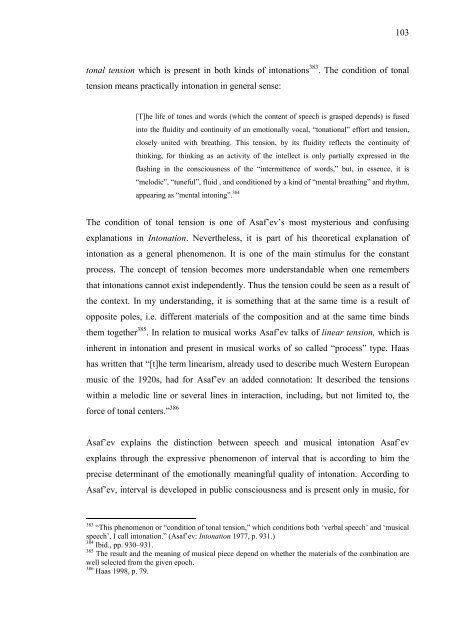Boris Asaf'ev and the Soviet Musicology - E-thesis
Boris Asaf'ev and the Soviet Musicology - E-thesis
Boris Asaf'ev and the Soviet Musicology - E-thesis
You also want an ePaper? Increase the reach of your titles
YUMPU automatically turns print PDFs into web optimized ePapers that Google loves.
103<br />
tonal tension which is present in both kinds of intonations 383 . The condition of tonal<br />
tension means practically intonation in general sense:<br />
[T]he life of tones <strong>and</strong> words (which <strong>the</strong> content of speech is grasped depends) is fused<br />
into <strong>the</strong> fluidity <strong>and</strong> continuity of an emotionally vocal, “tonational” effort <strong>and</strong> tension,<br />
closely united with breathing. This tension, by its fluidity reflects <strong>the</strong> continuity of<br />
thinking, for thinking as an activity of <strong>the</strong> intellect is only partially expressed in <strong>the</strong><br />
flashing in <strong>the</strong> consciousness of <strong>the</strong> “intermittence of words,” but, in essence, it is<br />
“melodic”, “tuneful”, fluid , <strong>and</strong> conditioned by a kind of “mental breathing” <strong>and</strong> rhythm,<br />
appearing as “mental intoning”. 384<br />
The condition of tonal tension is one of Asaf’ev’s most mysterious <strong>and</strong> confusing<br />
explanations in Intonation. Never<strong>the</strong>less, it is part of his <strong>the</strong>oretical explanation of<br />
intonation as a general phenomenon. It is one of <strong>the</strong> main stimulus for <strong>the</strong> constant<br />
process. The concept of tension becomes more underst<strong>and</strong>able when one remembers<br />
that intonations cannot exist independently. Thus <strong>the</strong> tension could be seen as a result of<br />
<strong>the</strong> context. In my underst<strong>and</strong>ing, it is something that at <strong>the</strong> same time is a result of<br />
opposite poles, i.e. different materials of <strong>the</strong> composition <strong>and</strong> at <strong>the</strong> same time binds<br />
<strong>the</strong>m toge<strong>the</strong>r 385 . In relation to musical works Asaf’ev talks of linear tension, which is<br />
inherent in intonation <strong>and</strong> present in musical works of so called “process” type. Haas<br />
has written that “[t]he term linearism, already used to describe much Western European<br />
music of <strong>the</strong> 1920s, had for Asaf’ev an added connotation: It described <strong>the</strong> tensions<br />
within a melodic line or several lines in interaction, including, but not limited to, <strong>the</strong><br />
force of tonal centers.” 386<br />
Asaf’ev explains <strong>the</strong> distinction between speech <strong>and</strong> musical intonation Asaf’ev<br />
explains through <strong>the</strong> expressive phenomenon of interval that is according to him <strong>the</strong><br />
precise determinant of <strong>the</strong> emotionally meaningful quality of intonation. According to<br />
Asaf’ev, interval is developed in public consciousness <strong>and</strong> is present only in music, for<br />
383<br />
“This phenomenon or “condition of tonal tension,” which conditions both ‘verbal speech’ <strong>and</strong> ‘musical<br />
speech’, I call intonation.” (Asaf’ev: Intonation 1977, p. 931.)<br />
384<br />
Ibid., pp. 930–931.<br />
385<br />
The result <strong>and</strong> <strong>the</strong> meaning of musical piece depend on whe<strong>the</strong>r <strong>the</strong> materials of <strong>the</strong> combination are<br />
well selected from <strong>the</strong> given epoch.<br />
386<br />
Haas 1998, p. 79.

















